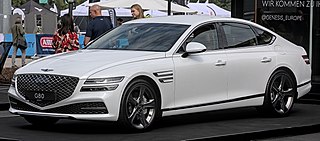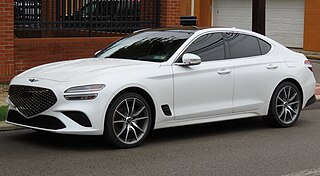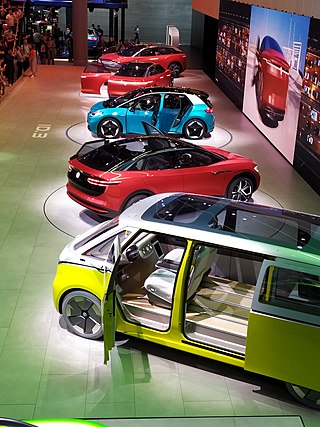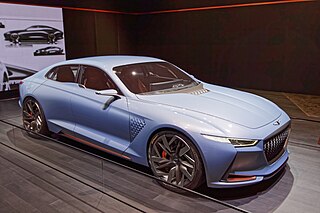
The Detroit Auto Show, formerly known as the North American International Auto Show (NAIAS), is an annual auto show held in Detroit, Michigan. Hosted at Huntington Place since 1965, it is among the largest auto shows in North America, and is widely regarded as one of the automotive industry's most important events.

The New York International Auto Show is an annual auto show that is held in Manhattan, New York City in late March or early April. It is held at the Jacob Javits Convention Center. It usually opens on or just before Easter weekend and closes on the first Sunday after Easter.

The International Motor Show Germany or International Mobility Show Germany, in German known as the Internationale Automobil-Ausstellung, is one of the world's largest mobility trade fairs. It consists of two separate fairs, that subdivided in 1991. While the IAA Mobility displays passenger vehicles, motorcycles and bikes, the IAA Transportation specializes in commercial vehicles. Before the separation, the show was held solely at the Messe Frankfurt.

The Los Angeles Auto Show, also known as the LA Auto Show, is an auto show held annually at the Los Angeles Convention Center in Los Angeles, California, United States. It is open to the public for ten days, filling 760,000 square feet (71,000 m2) of exhibit space. Since 2006 the event is held in November or December.
The Hyundai California Design (HCD) concept vehicles were designed at the Hyundai Motor Company's California studio for the North American market. The first concept vehicle, the HCD-1, was a targa-top sports car aimed at the Mazda Miata, and was unveiled in 1992, but was never produced. Other HCD-branded concepts have previewed production models; for example, the HCD-14 Genesis was a large sedan which eventually reached production as the second-generation Hyundai Genesis.

The Hyundai Genesis is an executive car manufactured and marketed by Hyundai Motor Company over two generations from 2008 until 2016, before it was renamed the Genesis G80. It is a five-passenger, four-door, rear- or all-wheel-drive sedan.
Eric Stoddard, is an automobile and industrial designer who has worked for DaimlerChrysler and Hyundai Kia Automotive Group.

Hyundai Motor America, doing business as Hyundai Motor North America is the operating subsidiary that oversees all operations of Hyundai Motor Company in Canada, Mexico, and the United States. Along with Hyundai's USA manufacturing plant in Montgomery, Alabama called Hyundai Motor Manufacturing Alabama, Hyundai has total of 19 manufacturing plants globally. Its operations include research and development, manufacturing, sales, marketing, after sales and corporate functions, which are controlled by HMA but sometimes executed by other subsidiaries and holding companies. The company is headquartered in Fountain Valley, California.

Genesis Motor, LLC, commonly referred to as Genesis, is the luxury vehicle brand of the South Korean vehicle manufacturer Hyundai Motor Company. Initially envisioned along with plans for Hyundai's new luxury Genesis sedan in 2004, Genesis was announced as an independent brand on 4 November 2015. Its first model, the Genesis G90, was released in 2017. Genesis models are designed in Rüsselsheim, Namyang, and Irvine, and produced in Ulsan.

The Genesis G80 is an executive sedan manufactured by South Korean luxury marque Genesis, which is owned by Hyundai Motor Company. The G80 model was previously introduced as the second-generation Hyundai Genesis model (DH) and then rebranded as the G80 in 2016 after Genesis Motor was established as a separate luxury division of Hyundai.

The Lexus LC is a grand tourer manufactured by Lexus, a luxury division of Toyota. Based on the 2012 LF-LC Concept, it was revealed at the 2016 North American International Auto Show in Detroit. It replaced the SC, which was produced from 1991 to 2010. The LC is the first Lexus model to utilize the GA-L platform, which, along with other components, is shared with the full-size XF50 series LS sedan. According to Lexus, the name "LC" stands for "Luxury Coupe".

The Genesis G70 is a four-door compact executive car manufactured by the Korean luxury automaker Genesis, a luxury division of Hyundai Motor Group.

The Volkswagen ID. series is a family of battery electric cars from Volkswagen (VW) using its MEB platform that is developed by the Volkswagen Group for a range of vehicles.

The Genesis GV80 is a mid-size luxury crossover SUV manufactured and marketed by Genesis, Hyundai's luxury division.
The Genesis Mint is a concept car made by Genesis Motor, the luxury subdivision of Hyundai Motor Company. It is a battery electric vehicle with limited range and seating, targeting the market for a luxurious city car. Unlike typical small city cars, it does not feature a rear hatch, instead offering access to its cargo space through scissor doors mounted on each side.

The Genesis X is a concept vehicle built by Genesis Motor, the luxury sub-brand of Hyundai Motor Company. The grand touring coupe is powered by a battery electric drivetrain and was first exhibited in late March 2021. Styling details reflect the marque's "athletic elegance" and "two lines" design language.

The Hyundai i-oniq was a concept sporty three-door hatchback designed and built by Hyundai Motor Corporation that featured a battery electric powertrain supplemented by a range extending gasoline engine, introduced in March 2012 at the Geneva Motor Show. Its name is a portmanteau of the words "ion" and "unique", which was later reused in 2016 when Hyundai began selling the Hyundai Ioniq. Hyundai subsequently launched the sub-brand Ioniq in 2020 to market electric vehicles built on the E-GMP architecture.

The Genesis New York is a concept car made by Hyundai Motor Company for its luxury division, Genesis Motor. It debuted at the 2016 New York International Auto Show with a hybrid gasoline-electric drivetrain, previewing the Genesis G70 production automobile.

The Hyundai N Vision 74 is a concept sports car developed by Hyundai, based on the 1974 Pony coupe unveiled at the Turin Auto Show in 1974. The vehicle was unveiled as a concept car at N Day 2022, an event organized by the Hyundai N performance division in mid-July 2022 at Busan, South Korea, alongside the Hyundai RN22e concept based on the Hyundai Ioniq 6 electric vehicle. The N Vision 74 is a rear-wheel-drive coupe driven by two electric traction motors, both on the rear axle; power is provided by both a storage battery and a hydrogen fuel cell.

The Hyundai Vision FK is a concept car that uses a plug-in hybrid drivetrain with both a large traction battery and a hydrogen fuel cell; the concept vehicle was developed by Hyundai and Rimac Automobili. The mid-motor, rear-wheel-drive sports coupe was unveiled at the Hydrogen Wave Forum in September 2021, an event organized by Hyundai to outline its plans to popularize hydrogen vehicles by 2040 for "Everyone, Everything and Everywhere". Power is delivered through two electric traction motors, both on the rear axle. The Vision FK can be plugged in to recharge its traction battery, which has more than 60 kW-hr of energy storage capacity, and the onboard fuel cell affords it a range greater than 600 km (370 mi).

















